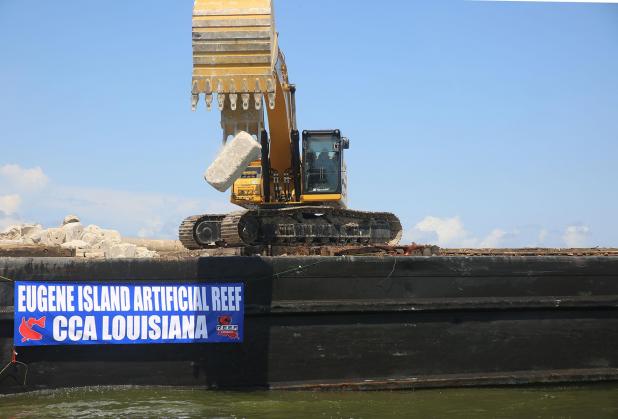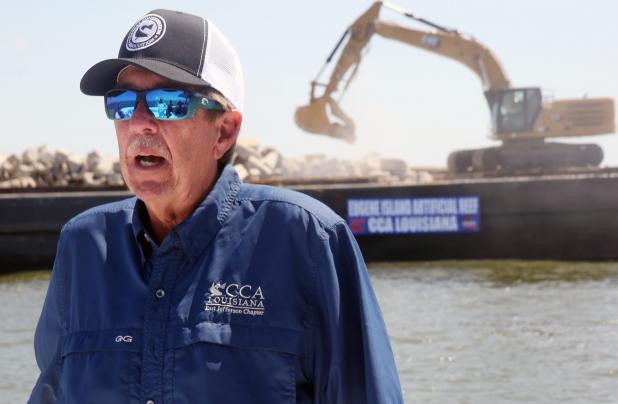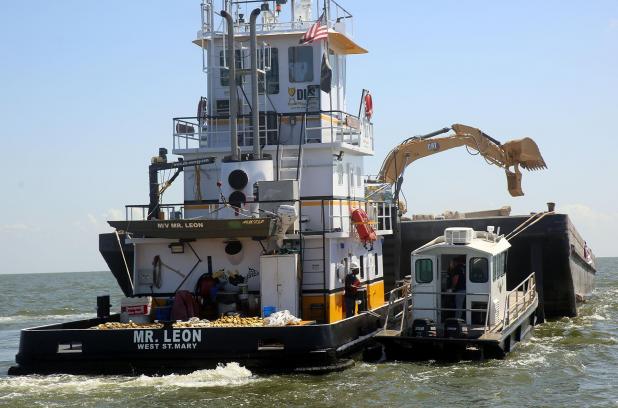
Concrete debris is dropped into the water off Burns Point to build an artificial reef that will attract marine organisms and the game fish that feed on them.
The Review/Bill Decker

John Walther, a vice president with the Coastal Conservation Association of Louisiana, says the organization has worked on eight artificial reef projects in the last year.

The tug Mr. Leon holds a barge in position so workers can place large pieces of concrete debris under the water. The reef will be 5 feet high in water that is 17 feet deep.
Recycled reef off Burns Point will be good for more than just fishing
CYPREMORT POINT — State Rep. Stuart Bishop represents Lafayette in the Louisiana House. But he has deep ties to St. Mary, too.
Bishop is a Hanson Memorial grad. One grandfather, Donald Bishop, moved his camp from Lake Fausse Pointe to Cypremort Point 40 years ago. His other grandfather, Beverly Furnier, was a Kerr-McGee foreman when Morgan City was the staging base for the first oil well put into production out of sight of land in 1947.
The family history helps explain why Bishop, R-Lafayette, was at Wednesday’s photo op for a new artificial reef south of Burns Point.
“I have two boys who love to fish,” Bishop said. “I hope they’ll have the good luck to have better places to fish than I had.”
That’s one of the goals of the new artificial reef being built in Eugene Island Block 51, 43 miles southwest of Morgan City. But, good angling is only one of the benefits.
The Coastal Conservation Association planned the work. Corporate sponsors got behind the effort with equipment and labor. And it will become part of a Louisiana Department of Wildlife & Fisheries network of reefs.
The reef will recycle concrete debris, mostly old pilings and pipeline weights. The debris will be built to a height of 5 feet in 17 feet of water in an area of about 4 acres.
The work took two years to plan and was expected to be complete after seven to 10 days.
On Wednesday, the association took a boatload of reporters and dignitaries from the Quintana Boat Launch to the reef site. There, the tug Mr. Leon out of the Port of West St. Mary played shepherd to a barge. On the barge was equipment volunteered by DLS Construction, dropping pieces of broken concrete, some as big as refrigerators, into the water. The concrete comes from Road Rock Recycling in Scott.
DLS and Road Rock are two of the project’s corporate sponsors. The third is Chevron.
“Louisiana is one of the nation’s greatest assets,” said John Walters, a member of Chevron’s state government affairs team. “And coastal Louisiana is one of Louisiana’s greatest assets. …
“Coastal Louisiana is where our employees live, work and play. To rehabilitate and conserve Louisiana’s coastal resources gives us great pride.”
The concrete will replace an energy platform that was removed about eight years ago. Before the removal, the association said, the area was a good place to catch speckled trout.
The reef, said John Walther, a vice president with the Coastal Conservation Association of Louisiana, means the fishing will be better.
Like the platform that once poked from the water at the site, the reef will provide a place for marine organisms such as coral and sponges that need something more solid than the soft sea bottom beneath Louisiana waters.
“Hard structures are required for marine organisms to have attachment points,” Walther said. “Providing this hard surface will initiate the marine food cycle.”
That means more of the creatures that game fish like to eat. It also creates, or at least enhances, a whole ecosystem.
The association has worked on eight such reef projects in the last state budget year.
“We monitor the reefs of the coastal area to evaluate their efficiency and effectiveness,” Walther said.
One more benefit has to do with what have become magic words in the energy industry: carbon sequestration.
Those marine organisms that cling to the reef absorb carbon dioxide from the water, Walther said. And that can reduce the level of the greenhouse gas in the air as well as the water, where carbon dioxide can increase acidity.
The association’s REEF Louisiana program has now conducted eight reef projects. The Eugene Island reef is the 32nd since the association in recent years, resulting in a $20 million investment.
The $250,000 cost of the Eugene Island reef comes from the association, its Building Conservation Trust, Chevron, and the Wildlife and Fisheries Artificial Reef Trust Fund. Individual donations from CCA Reef Louisiana Club members were also used for the work.
The association says it’s the largest marine resource conservation group of its kind in Louisiana with 30,000 member and volunteers in 30 local chapters.
